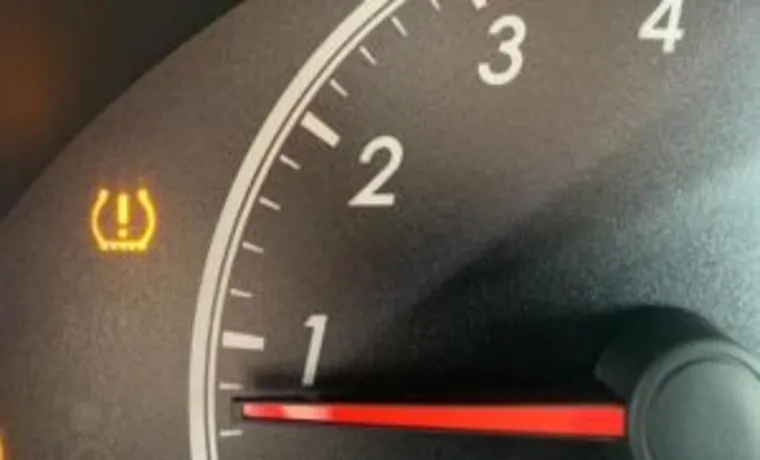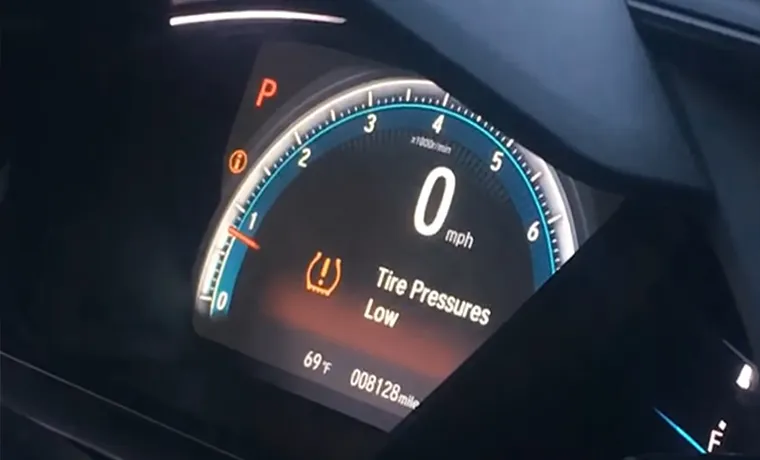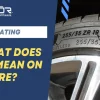Picture this: you get into your Honda and notice that the tire pressure light is on. Worried about your safety, you immediately take your car to the nearest gas station and fill your tires to the recommended pressure. But, to your frustration, the tire pressure light is still on.
What’s going on? Why won’t the light go off? In this blog post, we’ll explore the reasons why your tire pressure light may still be on after filling your tires on your Honda, and what you can do to fix it. So, buckle up and let’s dive in!
Table of Contents
Check the Tire Pressure Again
If you’ve filled your Honda’s tires with air and the tire pressure light is still on, don’t fret. There could be a few reasons why the light is still on. First, check the tire pressure again.
It’s possible that your tire pressure was low enough to trigger the sensor, but not enough to be corrected by the air you added. Additionally, temperature changes can cause tire pressure to fluctuate, so you may need to add more air. Another possibility is that there is a leak in one of your tires, causing the pressure to drop again shortly after you filled them.
Check for any visible damage or punctures in your tires and get them repaired if necessary. If you’ve ruled out these possibilities and the light is still on, it may be a malfunctioning sensor or electrical issue that requires a trip to the mechanic. Overall, don’t ignore the tire pressure warning light – it’s there to keep you and your Honda safe on the road.
Use a Tire Pressure Gauge to Measure the Pressure
Tire Pressure Gauge One of the most critical factors in keeping your vehicle safe and efficient on the road is maintaining the proper tire pressure. It’s not enough to simply eyeball the tires and assume they’re adequately inflated. The best way to ensure you have the correct tire pressure is to use a tire pressure gauge.
Simply remove the valve cap, place the gauge on the valve stem, and press down until you get a reading. But it’s important to check the tire pressure again after a few minutes to confirm the reading is accurate. Additionally, make sure you’re using the correct pressure for your specific vehicle.
Overinflated tires can be just as dangerous as underinflated tires, so taking the time to check your tire pressure regularly can help you prevent accidents, extend the life of your tires, and improve your gas mileage. So grab your tire pressure gauge and take a few minutes to give your tires some TLC. Your car and your wallet will thank you!

Refer to Your Honda Owner’s Manual for Recommended PSI
When it comes to maintaining your Honda’s tires, there is one crucial step that can often be overlooked: checking the tire pressure again. While you may have diligently filled your tires to the recommended PSI (as indicated in your Honda owner’s manual), tire pressure can fluctuate based on factors such as changes in temperature or driving conditions. It is recommended to check your tire pressure at least once a month and before any long trips to ensure maximum safety and fuel efficiency.
Investing in a tire pressure gauge can make this process quick and easy, allowing you to quickly identify any tires that may need some extra air. Remember, maintaining proper tire pressure not only extends the life of your tires but also helps save you money in the long run by improving fuel economy. So take a few minutes to check your tire pressure again – it’s a small task that can make a big difference in the performance of your Honda.
Look for a Damaged Tire
If you’re wondering why your tire pressure light is still on after filling your Honda’s tires, it may be a sign of a damaged tire. It’s not uncommon for tires to sustain injuries from road debris, such as nails or glass, causing slow leaks in the tire. Sometimes, you might not even realize that your tire is leaking air until your tire pressure light illuminates on your dashboard.
In this case, filling your tire with air will only provide temporary relief, and the light will come back on after a short while. The best way to address this issue is to inspect your tires for damage, such as punctures or cracks, and have it repaired or replaced as soon as possible. Remember that driving on a damaged tire can lead to serious consequences, so it’s better to be safe and address the problem promptly.
So, don’t ignore your tire pressure light, as it could be alerting you of a more serious underlying issue.
Inspect Each Tire for Cuts, Punctures, or Bulges
When it comes to keeping your vehicle in its best condition, inspecting each tire for cuts, punctures, or bulges should be at the top of your list. A damaged tire can not only cause a blowout while driving, but it can also decrease the overall lifespan of your tire. To ensure your safety on the road, take the time to look for any external signs of damage on each tire.
You can do this by visually inspecting each tire’s sidewall and tread for any bulges, cuts, or punctures. If you notice any damage, it’s important to replace the tire as soon as possible. Ignoring a damaged tire can lead to costly repairs and even accidents.
So, the next time you take a look at your vehicle, don’t forget to inspect each tire carefully!
Replace or Repair Any Damaged Tires
When it comes to taking care of your vehicle, your tires are one of the most important components to keep an eye on. Not only do they provide essential mobility, but they are the first line of defense when it comes to your safety on the road. It’s important to look for any signs of damage on your tires regularly.
Anything from small punctures or cracks to slashes and sidewall bulges can compromise the integrity of your tires. If you spot any of these signs, you should have them replaced or repaired immediately. Not only will this prevent any sudden blowouts or other dangerous scenarios while driving, but it will also save you from the headache of getting stuck on the side of the road waiting for a tow truck to arrive.
Remember, your tires are the foundation of your car’s stability and safety, so don’t skip out on giving them the attention they deserve!
Inspect the Valve Stems
If you’ve recently filled your tires on your Honda and the tire pressure light is still on, you might want to inspect the valve stems. Valve stems are known to wear out over time, which can cause air to leak out of your tires, resulting in lower tire pressure. It’s easy to overlook this part of your tire, but it’s important to check the condition of valve stems periodically.
Look for any cracks or damage that could be causing air to escape. In some cases, the valve core may need to be replaced, which you can do yourself or have a professional do it for you. If the valve stems are in good condition and the tire pressure light is still on, it might be time to take your vehicle to a Honda service center to get your system inspected.
Don’t ignore the tire pressure light – it could be an indication of a serious issue that could compromise your safety on the road.
Check for Damage or Leaks in the Valve Stems
Valve Stems Inspection Checking for any damage or leaks in the valve stems is crucial to ensure the safety and proper functioning of your vehicle. Valve stems are responsible for holding the tire’s air inside its casing, maintaining its pressure, and allowing for air to be added or removed when needed. A damaged valve stem can result in a slow leak, leading to a flat tire or even a blowout while driving.
To inspect the valve stems, start by examining each stem visually for any obvious signs of wear and tear such as cracks, cuts, or bends. If any are present, it’s advisable to replace the correspondent valve stem before it fails. Valve stems should also be free of any debris, dirt, or corrosion that could lead to air leaks.
Next, check for any air leaks by applying a soapy solution to the valve stem and watching for bubbles. If bubbles appear, it signals that air is escaping from the valve stem, indicating that it’s time to replace or repair the valve stem. Overall, the check for damage or leaks in the valve stems is simple and quick, but its importance shouldn’t be understated.
Regular inspection can help you avoid expensive and unexpected tire replacements or even worse, dangerous blowouts. Make it a habit to inspect your valve stems at least every few months to ensure your tires are always reliable and safe.
Replace Any Faulty Valve Stems
Valve stems are a vital component of any vehicle’s tires, helping to regulate tire pressure and maintain the tire’s structural integrity. To ensure that your vehicle is operating safely and efficiently, it’s essential to inspect the valve stems regularly. Look for any visible signs of wear and tear, such as cracks, leaks, or loose fittings.
If you notice any issues with the valve stems, it’s crucial to replace them promptly. Leaving faulty valve stems in place can lead to tire blowouts or other dangerous situations. By replacing any faulty valve stems, you’ll help ensure the longevity and safety of your vehicle’s tires, helping you stay on the road with confidence.
Remember to keep an eye out for any warning signs and replace your valve stems as needed to ensure peak performance and safety.
Reset the Tire Pressure Monitoring System
If you’ve recently filled your tires with air but your Honda’s tire pressure light is still on, don’t worry – this is a common issue. In most cases, it simply means that the Tire Pressure Monitoring System (TPMS) needs to be reset. Fortunately, resetting the TPMS is a fairly quick and easy process that you can do yourself.
First, ensure that all four tires are properly inflated to the recommended pressure. Next, turn on the ignition (but don’t start the engine) and press and hold the TPMS reset button until the TPMS indicator blinks twice. Release the button, turn off the ignition, and then turn it back on again.
Finally, drive your vehicle for several minutes to allow the TPMS system to reinitialize. If the tire pressure light is still on after resetting the TPMS, it may be a sign that you have a puncture or other tire damage that needs to be addressed. In this case, you should take your vehicle to a trusted mechanic or tire specialist for an inspection to ensure your safety on the road.
Consult Your Honda Owner’s Manual for Instructions
When it comes to maintaining your Honda vehicle, it’s important to always consult your Honda Owner’s Manual for instructions. One task that may need to be done periodically is resetting the Tire Pressure Monitoring System. This system is designed to alert you when your tire pressure is low, which can greatly impact the handling and safety of your vehicle.
To reset the system, you’ll need to follow the specific instructions outlined in your manual. However, the general process typically involves pressing a reset button or driving the car at a certain speed for a period of time. By resetting the Tire Pressure Monitoring System, you can ensure that your Honda is always operating at its best and that you are alerted to any potential issues with your tire pressure.
So next time your TPMS light comes on, refer to your Owner’s Manual for the proper steps to reset it and get back on the road safely.
Visit a Reliable Mechanic
If your tire pressure light is still illuminating after filling your Honda tires, the first thing to do is check the pressure again. Make sure that all four tires are at the recommended level indicated in your owner’s manual. If the light persists, it may be an indication of a more severe issue and visiting a reliable mechanic is recommended.
A qualified professional will perform a comprehensive inspection to determine the root cause of the problem. The issue could be anything from a leaky tire valve to faulty sensors in the tire pressure system. A mechanic will diagnose the problem and offer you advice on whether it can be fixed or if the system needs replacement.
Being proactive and quickly identifying the cause of the problem can help prevent further issues and ensure that you can drive your Honda with peace of mind.
Get a Professional Inspection and Repair if Needed.
If you’re concerned about the condition of your vehicle, it’s best to take it to a reliable mechanic for an inspection. They’ll be able to identify any issues that need to be addressed and recommend repair options. A professional inspection can help catch potential problems early on, before they become more costly and difficult to fix.
It’s always better to be safe than sorry, especially when it comes to your safety on the road. Don’t wait until your car breaks down – take it to a mechanic you trust and have peace of mind while driving. Remember, preventative maintenance is key to keeping your car running smoothly and safely.
Stay on top of any necessary repairs and enjoy your ride for years to come.
Conclusion
Well, my dear friend, it seems that your tire pressure light is like a persistent ex who just won’t take the hint. Maybe the tires weren’t inflated to the right pressure, or maybe there’s a sensor issue. Whatever the case, it’s time to channel your inner mechanic and get to the bottom of this.
And who knows, maybe fixing this will earn you enough good karma to finally get that elusive call back from your ex.”
FAQs
Why did my Honda’s tire pressure light turn on?
The tire pressure light turns on when the pressure in one or more of your tires is below the recommended level.
How do I fill my Honda’s tires to the correct pressure?
First, consult your owner’s manual for the recommended tire pressure. Then, use a tire pressure gauge to measure the pressure in each tire and fill as needed.
What is the correct tire pressure for my Honda?
The recommended tire pressure for your Honda can typically be found on the driver’s side door jamb or in the owner’s manual.
Why is my tire pressure light still on after I filled my tires?
There could be a few reasons for this. It’s possible that you didn’t fill your tires to the correct pressure levels or that there is an issue with one of your tire’s sensors.
Is it safe to drive with the tire pressure light on?
It’s best to address the issue as soon as possible, as driving on underinflated tires can lead to reduced fuel efficiency, uneven tire wear, and potentially dangerous driving conditions.
How often should I check my Honda’s tire pressure?
It’s recommended to check your tire pressure at least once a month, as well as before any long road trips.
Can a Honda dealer help fix my tire pressure issue?
Yes, a Honda dealer can inspect and diagnose any issues with your tire pressure and make necessary repairs or replacements.



